 What happened with my book deal: Over the summer, I published my second book - Balance and Your Body: How Exercise Can Help You Avoid a Fall. I was really happy with how it turned out, and I’ve gotten great feedback. I’ve almost sold out of my first printing her in Ottawa (but I can order more at any time, if you’re interested in purchasing a copy!), and it’s selling steadily on Amazon. It was time to move on to my third book.
In early September, I received an email through my website about Balance and Your Body. An editor at a New York-based publisher had found my book on Amazon and wanted to know if I was interested in updating it and re-releasing it with them, or writing another book on the same topic for them to publish. I asked around about this type of occurrence — i.e., a self-published author being headhunted by a publishing company — and although it is rare, it does happen from time to time. I hopped on a call with the editor to find out more. From the first contact, I had always been willing to walk away if the proposal didn’t work for me. We exchanged many emails while she prepared a pitch for the larger editorial team. Then we hit radio silence. I figured her pitch had been rejected, so I moved on with my own writing/self-publishing timeline, and more or less forgot about it. Fast forward to October, when another person from the same publisher reached out, explaining that the first editor had left for another job. Was a I still interested in producing a balance/exercise book with them? Sure! More emails and phone calls, as they outlined how the book would look different coming through their publishing house. This included me producing and sending to them lots of sample photographs of the exercises (I had used illustrations in my book, to keep costs low, and to make the exercises seem more approachable to all). Again, another lapse of time after their pitch and an eventual follow-up with me. I honestly thought I was being ghosted for a second time by the same company. Late last week, I finally received an offer and a contract to review. I already had the names of several literary lawyers to contact, should this day arise. Yesterday, I spent one hour on the phone with one of these lawyers, going through the contract line by line. At the end our call, I had five pages of notes: sections where she recommended I have them strike portions, amend others, and have frank discussions with them before signing. The advance they were offering was going to be chewed up by a photographer that I would be hiring to do photo versions of all the exercises. There were also a lot of restrictions around publishing other books—and I currently have three more in progress—as well as ownership and rights around the book I would be producing for them. The original “Balance and Your Body” was meant to be a small book, so I was happy that it came in just under 120 pages. As my future collaborator, Dr. Barry Franklin, said, I’m writing “little books with BIG impact.” I love that sentiment, and I love that my books are accessible. Balance and Your Body is 16,000 words, while they wanted to update it to a tome of 40,000 to 45,000 words. And part of the deal would have meant delisting Balance and Your Body. I was on the fence during the call with the lawyer. But deep down, I realized that I’m happier carving my own path at the moment. So I told them thank you but no thank you; that I wanted to stay self-publishing my books and being in charge of my catalogue. And they were really gracious when I turned them down. Here’s part of her response to me: “If anything changes in terms of your scheduling preferences or you come up with another idea that you think would be better suited to more traditional publishing, please feel free to circle back with me, as we’d be open to talking.” Never say never, who knows if I’ll come up with an idea that I’ll want to publish with them. In the meantime, I’m chugging away on my first novel, and the germ of an idea for my next novel popped into my head as I walked to work early this morning!
0 Comments
 Over the summer, I made the difficult decision to put my mobile fitness business on hold and return to the paid workforce. As with any loss, I cycled through the stages of grief: denial, anger, bargaining, depression, acceptance. But I was surprised with what happened when I arrived at acceptance. I felt like an incredible weight had been lifted off my shoulders; I felt relief with my decision. A huge relief, actually. This relief, though, was coupled with an incredible sense of failure. Like, I couldn’t make it as an entrepreneur. That I had failed because my business wasn’t bursting at the seams. That I had failed because I was relieved to be putting it aside.
My job search was then another source of emotional turmoil. I had a wealth of experience, in both breadth and depth. And yet, I wasn’t even getting called for interviews. Well, that’s not exactly true. I did complete phone interviews for a pair of jobs. In one case, I advanced to the next stage: a video interview with my potential new boss. In the other case, I hadn’t impressed them enough to move forward in the process. And in both cases, I was dropped from the candidate pool. Was it because of my age? I had turned 50 a few months earlier, and wondered if ageism was rearing its ugly head. But deep down, I again felt relief, because I knew I didn’t want to go back into an office full-time. Heck, I even clung to not being available full-time by scheduling a Friday morning class for 12 weeks. And then I decided that I should relax my job search criteria, open myself to part-time opportunities. I still have a house and family that require care and feeding. Roles that require time and effort, and which I take very seriously. My frustration mounted when I was even being considered for part-time roles. Was I now over-qualified? I went for a walk to clear my head and figure out what I wanted to do with my life. Heck, I was still joking that I don’t know what I want to be when I grow up. But on that walk, a thought popped into my head: “I just want to write!” It was a bit of an epiphany, and I started reflecting on how much I had accomplished in the past 18 months, since I first decided to write and self-publish a book. Shortly after my first book was published, I was invited onto a Facebook Live broadcast to discuss my book and my journey of self-publication. The interviewer asked me if I had always known I wanted to be a writer. At the time, I didn’t have a clear answer for her. Since then, though, I’ve thought about it and realized that yes, deep down I always wanted to be a writer. I’m reminded of an elementary school project. I must have been in grade four or five at the time. Each student was required to complete a personal coat of arms. Included in the four quadrants were the past, present and future. In the future section, I had drawn a book. I can’t recall the title of the book, but the author was clearly me. The by-line was “Mandy Joab, Ph.D.” (That’s my maiden name, in case you’re wondering. And yes, I used to go by Mandy instead of Amanda.) So I guess the answer to the question, “Have you always wanted to be a writer?” is “Yes!” And that’s why my website and social media presence evolved from Amanda Sterczyk Fitness to Amanda Sterczyk - Author. It’s my fourth career and it fits really well. Especially since I finally found a part-time job that works for me and my commitments. I’m still a mom with kids at home, so running our household is still near the top of the list. But the other thing that ranks pretty highly now is writing. The priority this month is my first attempt at fiction. After all, it’s NaNoWriMo, aka National Novel Writing Month. NaNoWriMo is an online community of writers, a virtual support group to encourage you to write the first draft of a 50,000 word novel in 30 days. I’m not officially registered on their website, but I am working towards a daily goal of writing 1,000 to 1,500 words. A few months ago, I first came up with the idea for a novel. It was after posting an excerpt from my upcoming fourth book, I Can See Your Underwear: My Journey Through the Fitness World. I had several people tell me that I’m a great storyteller and I should consider turning my skills to the world of fiction. An idea for a story started germinating right then and there. I’ve always had a very active imagination, and I love making up stories in my head. As I researched novel writing, one clear rule emerged: you must engage the reader. If you write a compelling story that keeps the reader engaged, anything is possible. And so, my creative juices began flowing. I read about plot and character development. I went for lots of solitary walks and daydreamed a lot, because that’s how my brain creates. I started a new file in my writing software (I use Scrivener and I love it), and began creating parts, chapters, sections, and characters. Last month, I began filling in the sections. And yesterday, the first day of the month, I wrote 1,400 words in the manuscript for Selfried and the Secret. This morning, I’ve produced only 300 words of fiction. But this post will come in at over 1,000 words. And after a walk, I know I’ll have more inspiration to continue on my novel. I’ll hit my 1,400-word target with room to spare. And if I’m on a roll with writing, who knows where I’ll stop today. I am a writer. I am an author. And I love my new career.  I’ve been carrying a secret around with me for over three months. Partly out of embarrassment — for me and for you, should I decide to share this secret with you. And partly out of a feeling of failure — as in, there must be something wrong with me to let this happen. Are you ready to hear my secret? It has to do with unmentionable parts of my body. Some people, both women and men, make faces, plug their ears, and exclaim absurdities like, “Ew!” when unmentionable topics are finally mentioned. If you’re one of those people, let me be blunt: it’s time to grow the fuck up and have an adult conversation. There are many conditions that impact women’s bodies, including the space south of the belly button, that are not discussed openly. And that’s a problem, because….well, there are many reasons this is a problem. Suffice it to say, I believe we all need to be more open about health issues so we can help ourselves and others.
So, here goes, I’m going to share my secret. For over three months, I’ve been struggling with pelvic organ prolapse — aka POP. In my case, my bladder has prolapsed. That’s right, my bladder decided to pull an Elvis — as in, she wanted to leave the building. Who knew after I turned 50 that I’d join a new group — those women with POP. As in, half of women over the age of 50, and one third of ALL women struggle with POP at some point in their lives. Yet we don't talk about it. I didn't know it was so common, and it's taken me a while to feel comfortable talking about it. It’s not just the diagnosis that can seem like an uncomfortable topic of conversation. The symptoms of POP can also render women shy and withdrawn:
In recent years, there has been an uptick in physiotherapists who are certified to treat pelvic floor conditions like POP. This makes a lot of sense to me: the pelvic floor is a group of muscles that supports the pelvic organs and physiotherapists are trained to help with malfunctioning muscles in every other part of your body. It was the right decision for me to first visit a pelvic floor physiotherapy. I knew exercises would help me sort things out with my body, so a visit to an expert was in order. When I finally visited my doctor’s office, the idea that a specialized physiotherapist could diagnose a prolapse was summarily dismissed. But that's a story for another time. Prolapse is not the only manifestation of pelvic floor dysfunction. Incontinence can also result, along with a host of other conditions. And, in fact, men can also experience pelvic floor dysfunction. In my mind, this is another great reason for us to be discussing what’s happening in our ‘nether regions’ in a non-sexualized fashion. Discussing unmentionables doesn’t begin and end with the pelvic floor. Within the pelvic region, other systems can break down and cause problems. Take endometriosis, for example. It affects 10 to 20 percent of women in their childbearing years (ages 15 to 49). So what exactly is endometriosis? It is “a condition in which tissue similar to the lining inside the uterus (called “the endometrium”), is found outside the uterus, where it induces a chronic inflammatory reaction that may result in scar tissue.” Just like pelvic organ prolapse, the symptoms of endometriosis can be difficult to discuss openly:
Recently, my friend Lara Wellman shared her journey to a diagnosis of endometriosis. Like many girls and women who suffer with undiagnosed endometriosis, she too has been experiencing painful periods since her teenage years. As Lara explains, “I put up with them my whole life. Then, last May, the pain was off the charts the entire day. To the point that I went to the ER to make sure I wasn’t dying. I haven’t had a pain-free day since.” Let that comment sink in: so much pain that she thought she was dying. And Lara has had kids, so she gets vaginal pain from childbirth. Like many “female issues,” the pain we experience during our periods is often dismissed as “just another thing we shouldn’t complain about.” After all, that’s what Midol is for — so the advertisers and medical community tell us. Yet this “normalization” of pain, and the need to not be seen as whining, keep women from talking about their symptoms. As Lara told me, “Doctors aren’t being taught about endometriosis, so they can’t put the pieces together.” Though they acknowledge menstrual pain, they also brush it off: “Oh ya, periods hurt. Try the pill or lots of Advil,” explains Lara. It’s yet another case where women put others' health and wellness ahead of their own. If our child or spouse was in so much pain, we’d be packing them off to the doctor immediately. When it comes to our own bodies, we let things slip when something’s not right “down there.” Look, I know I’m only scratching the surface here when it comes to unmentionable conditions. I haven’t even broached stuff like interstitial cystitis, polycystic ovary syndrome, pelvic inflammatory disease, uterine fibroids, or gynecologic cancers. My point is, we need to start being more open about what’s happening with our bodies. Because someone else is probably also suffering in silence.  Frequent, flexible, and free. That's my motto with Your Job Is Killing: A User's Guide to Sneaking Exercise into Your Work Day. Please read on to enjoy an excerpt from my upcoming third book. It will help you understand why I wrote this book, and how it can help you and your fellow professional sitters to sit less and move more at work. Your very life depends on it. (copyright 2019 Amanda Sterczyk, all rights reserved) It was an office job that precipitated my career change into the fitness industry. After spending several years at home with my young children, being confined to an office took its toll on my emotional and physical well-being. Endless meetings and conference calls where I felt chained to my chair were the norm. All I wanted to do was get up and go for a walk. In fact, at one point I was reprimanded for spending too much time visiting colleagues’ offices. Even though I was applying a 1980s solution to a 21st century problem, my boss thought my added movement was making me unproductive.
Do you have a desk-based job? Are you a professional sitter? The knowledge-based economy means that many adults sit at their desks and in meetings for hours at a time every day. Productivity, profit, and professionalism lead people to remain seated at all times. But we're not in an airplane, and there is no turbulence. This physical inactivity is killing us. This book will help teach you how to sneak “snacks” of exercise and movement into your work day. This is not some “let’s crush it with squats in the boardroom” type of book. It’s not about how to get the most out of your new treadmill desk. And it’s not an exercise manual either. There are plenty of resources available to show you how to exercise at work, including my free online course, “Add Movement at Work.” With this book, I want to show you that adding stuff to your office to encourage movement is not the most practical or cost-effective solution. Instead, I’ll show you that moving more at work needs to be frequent, flexible, and free. I’ll leave the sweaty, costly, and complex office workouts to others. If you read my first book, Move More, Your Life Depends On It, you’ll notice some similar content in this book. When Move More was first published, I was often asked, “Who is this book for?” My response was: for anyone who sits too much — for physically inactive office workers, for sedentary older adults, and for anyone who needs to break up the time they spend on their duff. Regrettably, some of these groups didn’t identify with the message in Move More because they didn’t “see” themselves portrayed in my first book. Hence this updated perspective, which is targeted specifically to professional sitters. You can visit Amazon to purchase your copy today.  Image source: Needpix Image source: Needpix The following excerpt is from my upcoming fourth book, I Can See Your Underwear: My Journey through the Fitness World. It describes my first in-home private training client in 2010. I was a new Essentrics® instructor, and completely naive about how to navigate the fitness world. (copyright Amanda Sterczyk 2019, all rights reserved) My very first private session was probably my scariest encounter. And it actually kept me away for privates for a few years after that. A woman had contacted me about an Essentrics standing and floor workout in her home. We’re talking early in my newfound fitness career, circa 2010. You know, pre-iPhone (for me), pre-social media checkins (for me), pre-Find My Phone apps (yup, you guessed it, for me). When you went somewhere, no one knew where you were. Unless you told them beforehand. That was my first mistake.
I arrived about two minutes before our scheduled time. My first doorbell ring went unanswered, while my second one had me greeted by a face peering past a chain lock. After introducing myself, my new client unlocked the door and revealed her workout clothing. It included a very see-through top, minus a bra for support. At least that’s what I think, as I looked away fairly quickly. When I did look away, my gaze fell over her interior. It appeared as if every square inch of floor space was filled. The technical term is hoarding disorder. My client backed up so I could enter the small, crowded foyer. As I was removing my shoes, she closed the door. I was still assessing the space in front of me, trying to determine if how one, let alone both of us, would have enough space to exercise. That was my second mistake, and we’ll circle back to it in a moment. My client invited me into a beyond-capacity living room. I had already determined that the floor portion of the workout was no longer feasible, so I was quickly assessing in my head how to modify the workout to be standing-only. You’ll recall that I was a very new fitness instructor, with limited instruction time under my belt, so thinking on the fly was a skill I had not yet acquired. I stumbled over my words as I explained to her that we’d be doing something a bit different. Then I asked her if we could move the coffee table so we could face each other in the room. She balked at the idea, so I quickly offered to stand in the hall while she stood between the sofa and the table. Let me explain a bit about Essentrics here before I continue: the workout is a non-impact, bodyweight routine that uses large, flowing movements in order to work the joints through their full range of motion. In addition to having space on your exercise mat to move, you need space in the air around so you don’t bang your hand or arm on anything. As you can well imagine, the current configuration was making it difficult to complete circulate movements in a flowing manner. I banged a few things as we were “moving” through the workout, something that was causing distress in my new client. I realized that this was probably going to be my one and only visit to this client’s home, a fact that wasn’t disappointing in the least. At the end of the thirty minutes, I turned to leave. And the door wouldn’t open. It turns out the client had locked the door from the inside, and thrown away the key (so to speak). But seriously, the door was locked, and the deadbolt was missing the required key. I looked around the cramped and messy vestibule to locate the key — I was suddenly feeling very uncomfortable and wanted some fresh air — but to no avail. Did I mention that, even though it was the height of summer, every door and window was shut tight, every curtain and blind was drawn. And, it would appear, every door was locked. A wave of panic rolled through my body. Shit, shit, shit. What had I gotten myself into? I was seriously questioning my new career, not at all comfortable in this current situation. Was she going to let me leave? Why was she taking so long to get to the door? Right, ALL the stuff blocking her path. I turned around just as she arrived by my side. She leaned over a small table with multiple, identical drawers. She opened one and extracted the key for the deadbolt. How had I never noticed her remove the key and place it in the drawer upon arrival?? Short answer: I was overwhelmed by the sheer volume of things in her house. Long answer (sort of): I was so trusting, that it never occurred to me to imagine a negative outcome; and yet, no one knew I was there. When the client finally unlocked and opened the door, I exited and headed for my car as quickly as possible. I drove home with all the windows open, taking lots of deep breaths along the way. And it wasn’t just for the fresh air. I had to calm my rattled nerves. I’m sure it will come as no surprise to you that this client never contacted me for a follow-up session. That was fine by me, because I would have refused. The entire incident scared the bejesus out of me. So much so, that it took several years until I was willing to entertain the thought of additional in-home private sessions. I would stick to group classes in more public spaces. Pretty ironic, don’t you think? 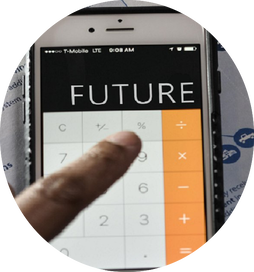 Last week, the world of professional football was stunned when starting quarterback Andrew Luck announced his retirement. It was at the end of a pre-season game, and few saw it coming. After all, Luck is only 29 years old; he’s in the prime of his NFL career. But he’s been saddled with injuries and pain. I think he made the right decision for his body. To be so young and in so much pain — pain that can be avoided. We discussed it a few days after the surprise announcement. The general consensus at the family dinner table was this: he’s smart to get out while he still has a chance to recover from his injuries and enjoy life. The topic got me wondering about my sudden departure from the world of fitness. (If you’re just tuning in, let me catch you up: I announced in July that I’m putting my fitness business on hold and returning to the paid workforce.)
Although I was sad when I made the decision and began dusting off my resume, I was also relieved. You see, I sustained two foot injuries in two consecutive years — and yes, the second injury was a direct result of lack of healing time from injury number one. After I got through the emotional journey of saying goodbye to my business that I’ve been nurturing and growing for nine years, I heaved a huge sigh of relief. Relief that my foot could finally heal properly and no longer cause me pain. I was still soldiering through classes and privates with clients, even though I was in pain most of the time. But the pain was impacting my personal time. In a nutshell, I wasn’t enjoying life. So consider this my official retirement…from fitness. You know I’ll still be writing books — Your Job Is Killing You will be out this fall — but the only workouts I’ll be doing, or not doing, are ones for myself. Because some days, I like to take a break and let my body rest. It’s tough to take a break from working out when fitness is your business. As I write this, I still haven’t found a job. But I’m optimistic that I’ll find the right role in the near future. It’s a retirement from fitness, but a new beginning in another field. 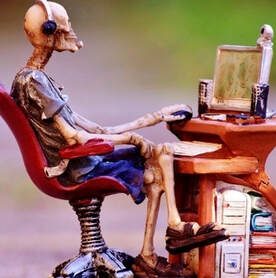 This month’s blog post is an excerpt from my third book, Your Job Is Killing You: A User's Guide to Sneaking Exercise into Your Work Day, which will be published later this year. If you like this — or any of the excerpts you’ve read from any of my books — please buy a copy. Authors depend on sales to pay the bills. If you’re in Ottawa, you can contact me to purchase your copy. If you’re elsewhere in the world, you can visit Amazon to purchase a paperback or e-book version. Are You a Professional Sitter? Do you work in a knowledge-based environment? That is, do you spend most of your working life either at a desk or at a table in a meeting room? If so, then congratulations, you are officially a professional sitter! But you’re not alone. Many adults around the world spend 50 per cent (or more!) of their waking hours mostly sitting. You know who you are — office workers who nab the first available seat on the daily commute, colleagues who remain seated during the breaks in meetings (seriously, the seat belt sign is off, you’ve been granted permission to move about the cabin), individuals who opt for the elevator/escalator/moving sidewalk instead of employing the heel-toe express, “watch watchers” who take a seat and await the timer countdown on their microwaved lunch. You get the gist — too much sitting and not enough moving. My slogan is “move more, feel better.” This simple message holds much power: the solution to your aches and pains, lack of motivation, and foggy brain is in your control. You can do it! Get off your butt and move about the cabin. As my client Janice said, “This is needed! I am retired after 35 years at a desk, getting up only to sit in a meeting. Only in the last few years was there recognition of the need to move more during the day. Good luck with your book!” 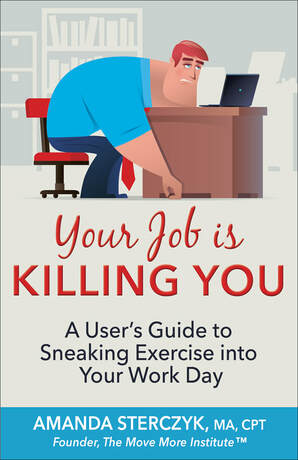 And I’m not the only one who feels this way. Take biomechanist and movement guru Katy Bowman. I’ve been reading her books for years, following her social media posts, and sharing her insights with my clients. You could say we’re kindred spirits in the world of natural movement. And she even has a book to help people incorporate stretches and movements at work. Bowman, like many of us in the world of practical fitness, feels strongly about more movement, more of the time: “For decades, researchers have been trying to figure out the best way to organize the body for optimal performance at the office. The underlying flaw in much of the research—or at least in the presentation of the research—is that it fails to highlight the use of a single position as the problem. Our quest to find an optimal position for stillness will always be frustrated by the problems inherent in a lack of movement.”* Copyright, 2019 by Amanda Sterczyk, all rights reserved.
*Katy Bowman, Don’t Just Sit There: Transitioning to a Standing and Dynamic Workstation for Whole-Body Health (United States of America: Propriometrics Press, 2015), p. 10. Reprinted with permission. 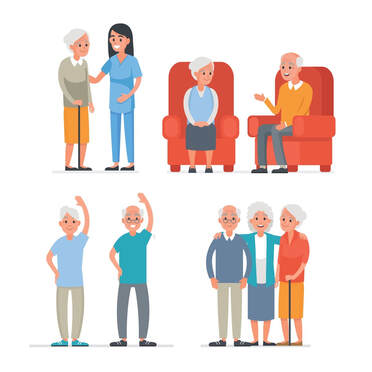 Now that my second book, Balance and Your Body: How Exercise Can Help You Avoid a Fall, is available to the public, I’ve had several people ask me who this book is for. As in, who is my target audience? I wrote this book as a self-help exercise guide for caregivers, family members, and, most importantly, seniors. It features a dozen foundational exercises with step-by-step instructions and illustrations that they can use as a home-based exercise plan. What’s different about my book? The exercises don’t require special equipment or the need to get on the floor. Each exercise also includes modifications on how to make it easier or harder, depending on abilities. Falls are the leading cause of injury, emergency room visits, and hospitalizations for seniors in North America. The goal with my book is to help seniors increase their confidence — after all, the fear of falling contributes to the risk of falling — and improve their strength and balance so they won’t sustain a life-altering fall. So let’s see how these distinct groups can utilize my book. 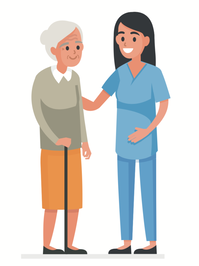 Caregivers. “Would you present to our staff about how to help our senior clients? You know, teach them easy exercises that they can do with clients during visits.” Be it a personal support worker, care aide, nursing assistant, or nurse, there are many professionals that provide care and support to seniors in their homes, in retirement homes, and in long term care facilities. Knowing how to help senior clients maintain balance and strength improves their ability to serve their client group. When I’ve presented to caregiver groups, they are so appreciative of the information I have shared. My book is easy to read and compact, so they can easily carry it from one appointment to the next. 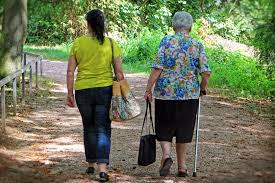 Family Members. “Can You Help My Aging Parent? They’re living alone and I’m in another city. I’m worried they’re going to fall and hurt themselves. They won’t go to a gym, and I saw on your website that you offer in-home fitness training to older adults.” I’ve seen many emails and received just as many phone calls like this. Increasingly, adult children are living in different cities from their elderly parents and they feel helpless. They may see their parents infrequently, and each time, the changes in their loved ones can be an eye-opener. Time is marching on and the physical declines are more marked with each passing visit. In many cases, they want to help their parents maintain their independence and stay in their homes. And they know one slip, trip, or fall is all that separates their mother or father from permanent residency at a long-term care facility. When I do visit their parents, we begin to work on the main components of fall prevention: balance, strength, and mobility. Do you have aging parents or grandparents whose lives you need to monitor in addition to your own life? You can pick up a copy of Balance and Your Body for your loved one, go through the exercises with them — remember, each exercise includes instructions on how to make it harder if you’re doing it with them — and/or leave the book with them for their own practice. Or are you an employer whose staff have aging parents? I’ve also presented to businesses, so their employees can help aging parents stay in their homes longer. These card-carrying members of the sandwich generation don’t have the time to research fall prevention exercises that they can teach their parents/grandparents. A lunch and learn to cover the basics of balance and how to prevent a fall will ease their minds and let them focus on how to help their aging loved ones when they’re not at work. 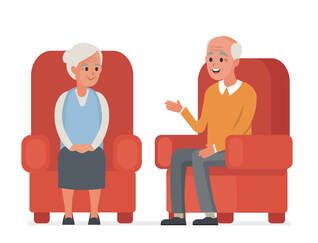 Seniors. “I want to be able to go for a walk with my husband.” This is just one of many fitness goals I hear from my senior clients. Finding time to do these exercises doesn’t have to be complicated. When I work with clients in their homes, I send follow-up emails that list and describe the exercises we’ve done together. My goal is to make clients comfortable doing the exercises on their own. In many cases, they write out the exercises on a sheet of paper for quick reference. You know, something that they can leave on the counter and refer to throughout the day. They often tell me that their list allows them to tackle the exercises one at a time, without feeling overwhelmed. I decided to compile these exercises in a book, as a quick reference guide for other seniors. And each exercise is a standalone passage. You can start with just one or try them all in one session. Whatever works for you. You will benefit either way. How to buy. Would you like a paperback or e-book version of Balance and Your Body? It’s available for sale worldwide on Amazon. And if you’re in Ottawa on July 11th, why don’t you join me for the official book launch? Because even if this book isn't geared to you, there's probably someone in your life who could benefit from it.
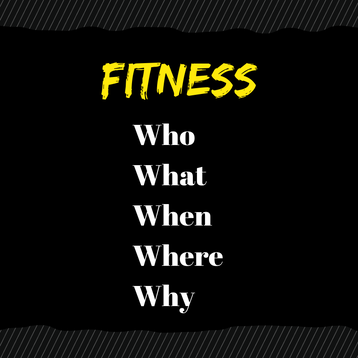 “One size fits all” is an erroneous premise, be it with hats, socks, or fitness. As a fitness professional, I get leery of statements that “everyone can do this workout.” Sure, everyone can, but does everyone want to? Let’s be honest, what motivates you isn’t going to motivate the next person. And you’re more likely to stick with a program if you find it motivating. So how do you figure that out? My suggestion is that you break it down by the five W’s of fitness. The five W’s can be traced back to Aristotle. They’re an investigative device that have been used by journalists, police, and authors, to name a few. In Aristotle’s case, he was examining ethics and determining voluntary versus involuntary action.(1) If an action is voluntary, these 5 questions should have answers:
And in the case of choosing of workout that’s right for you, it’s very much a voluntary endeavour. So let’s dive in and examine each component. “Why” appears last on this list. But the past decade has seen the order and prevalence of the five W’s flipped, thanks in large part to Simon Sinek’s 2009 book, Start with Why.(2) Beginning with the end — why — will help to answer the other W’s in the case of fitness too. 1. Why Why exercise? For the fun of it. I’m not being facetious, I truly mean that. Think about it: if you enjoy your workout regimen, you’re more likely to stick with it. But there are many other reasons you may choose to begin a new exercise program, and equally solid reasons for why you will stick with your current workout. I’ll help you begin your thought process by sharing my “why.” For me, I want to live a long and healthy life. So I exercise for life. And disease prevention, because exercise IS medicine. That was easy, now it’s your turn. Is it because you want to go for a walk with your spouse? Do you want to have the energy to play with your grandchildren? Do you like the feeling of strength from lifting heavy weights? There is no wrong answer here. 2. Who The first “who” is of course you. But that can be the beginning or the end of it. If you feel motivated to exercise on your own, or if you prefer the solitary aspect of solo workouts, there’s no need to include others. This is your fitness journey and yours alone. I get it if you want to opt for solo workouts. When I’m teaching group fitness classes or training private clients, I’m working on their fitness goals. So when it comes time to do my own workout, I prefer being with my own thoughts and going at my own pace. But that may not appeal to you. Perhaps you want the company of a friend or loved one, the anonymity of strangers in a group class, or the motivation of a personal trainer. If external accountability is important to you, you’ll probably want to recruit someone else to propel you forward in your fitness journey. 3. What At a broad level, fitness can be divided into four main components: cardiovascular or aerobic, strength, flexibility, and balance. But that only scratches the surface of what, exactly, you can do in terms of exercise. Different things will appeal to different people. And at different times in your life, the “what” of exercise will also change. Take me, for example. In my twenties, my go-to workout was cardio via running, including training for and competing in road races. I did it all: 5K, 10K, half marathon, and marathon. In my thirties, I discovered flexibility training with Essentrics. In my forties, I started picking up dumbbells and barbells to incorporate strength training into my life. And as I get ready to enter my fifties, I do all the same balance exercises that I teach to my senior clients. I do a little bit of everything in the “what" category, but in different proportions than in the past. 4. When Are you an early bird or a night owl? Do you prefer to exercise in the middle of the day? When you choose to get physically active will also dictate whether you’ll stick with your program. Although I get up early, I’m not a fan of early morning exercise. For me, early mornings are all about easing into the day. I once tried to teach an early morning Essentrics class. My body was there, but my brain and vocal cords preferred to stay at home. I was a babbling idiot, trying to string together coherent sentences. And I failed miserably. So, learn from my missteps: understand your motivation levels at different times of the day. It’s another key factor in sticking with it. I’m not just referring to time of day, but also number of times per week. Your body needs and craves movement every single day. If you think “getting it over with” in one monster session will get you through the week, think again. You may be overdoing it with too much exercise at once, and risk an injury as your body and mind tire and lose focus on proper form. Remember, I want you to exercise for life. As in, a daily habit that you’ll maintain for the long term. 5. Where There are so many options for where to workout. Weather permitting, outside is one of my favourite locations for exercise. You can also join a gym, but you don’t have to. Lots of people opt for exercising at home, which is why I go to my clients in their homes. I want to them to feel confident about exercising anywhere, including their own living room. And if you don’t want to hire a personal trainer, you can always use workout videos, streaming services, or YouTube to find a workout that’s right for you. That’s what I do when I don’t feel like heading outside or to the gym — I head to my living room instead. And often, I’ll work out in my pjs, because, why not?! So there you have it — the five W’s of fitness. I hope this list will help you make choices in your own fitness journey. And remember, one size doesn’t fit all. Epilogue: How Much You may be wondering why I haven’t addressed “how much” you should workout. While this is an important topic, the answer is likely not going to motivate you to get moving. And frankly, it’s the same for everyone; the guidelines apply to all and thus fit in the realm of “one size fits all.” Be that as it may, I’ll share the “how much” with you now. Perhaps it will encourage you to get moving. The Canadian Physical Activity Guidelines recommend that adults engage in 150 minutes of moderate to vigorous physical activity every week to maintain optimal health.(3) Although some health and fitness professionals recommend five bouts of 30 minutes each, it’s really up to you how accumulate your activity. Indeed, the guidelines highlight that the bouts be 10 minutes or more.* And we’re talking here about aerobic physical activity — hence the emphasis on “moderate to vigorous.” The point is to get your heart rate up. They also recommend two days to four days per week of strength training activities and four to seven days per week of flexibility and balance training. (4) *The US Physical Activity Guidelines were updated late last year, and they dispensed with the “10 minutes or more” guidance, in favour of physical activity in any amount.(5) This shift emphasizes the cumulative effect of physical activity throughout the day. References
 Ottawa is a great city for walking. It’s a walkable city, until it isn’t. This reduction in walkability is a direct result of wintry conditions: icy sidewalks, unplowed sidewalks, and blocked crosswalks are just a few of the problems that impact our ability to walk safely and avoid falling. In early January, I participated in the Snow Moles’ Walkability Audit of Old Ottawa South. The Snow Moles is an initiative of the Council on Aging of Ottawa. Snow Moles are volunteers who report on what it’s like to walk outside on a winter day in Ottawa. The information they gather will be used by Seniors Watch Old Ottawa South (SWOOS), OSCA, and the Council on Aging of Ottawa (COA) to inform the City and others of ways that winter walkability can and should be improved. Falls are not age-specific, but your risk of falling increases as you age. And if sidewalks are slippery due to snow and ice, anyone is at risk of falling. Intrepid volunteers like the Snow Moles are making the sidewalks safe for walking. But before you leave home, there are things you can do to reduce your risk of falling. As a fitness professional, I often get asked about the “best” exercise for a particular fitness goal or body part: eg, “What’s the best exercise to improve my balance?” Or, “what’s the best exercise to strengthen my quads?” The best exercise is the one you’re going to do. The exercises listed below are some of my clients’ favourites, and include both strength and balance components. Both are key factors in fall prevention. Strong muscles and bones allow us to lift our legs and feet over obstacles like pesky snow banks that haven’t been cleared. Or your big toe: when the muscles along the shin bone are weak, it’s more difficult to lift the front of your foot off the ground as you walk. Then your own body becomes a trip hazard. And balance is a critical component of walking - because walking is essentially a weight transfer and balance exercise. One foot, then the other. Repeat. If you’re having trouble with balance, how will you be with walking? Well, walking will also be difficult, and that’s when you’re most likely to risk a fall. Try these exercises in your home. Focus on slow, purposeful movements. Hang on to something solid if you need help with balance. And make sure the area is free of obstacles if you’re moving around. Alphabet Draw the letters of the alphabet with your foot to strengthen muscles around your ankle. High March (Stomp) Lift one knee to hip level and hold for 5 seconds. Lower the leg and switch sides. Heel raises Stand tall with your feet shoulder width apart. Rise up onto the balls of your feet, avoiding leaning forward. Hold for 3 seconds, then lower. Kitchen squats Face your kitchen counter and hang on with both hands. Open your legs to shoulder width and lower your behind down and back as if you’re sitting in a chair. Keep your back straight, knees above the feet, and weight on the heels. Push into your heels to come back up to standing. Switch Up Your Walking Sideways walking strengthens little-used muscles along the inside and outside of your legs. Backwards walking helps you strengthen your brain-body connection by creating new pathways in your brain, teaches your body to rely on the messages the nerves in your feet are sending to the penthouse, and it improves coordination in your lower body. NOTE: make sure the space is clear of obstacles and hang on to something solid. Balance Stand on one leg and try to hold for 30 seconds. Put your foot back down and repeat on the other side. To make it more challenging, try turning your head to one side. As we age, our balance is impacted negatively by our aging bodies: cells die in our vestibular system, which is connected to the centre in our brain that controls balance; - our vision declines and with it, our depth perception; - changes to our blood pressure may cause dizziness, lightheadness or blurriness; - we lose muscle mass, strength, and power — this can slow our reaction time if we trip; - our reflexes and coordination also decline; and - a variety of health problems may also impact our balance, including arthritis, stroke, Parkinson’s disease and multiple sclerosis. (1) Regular physical activity is key to maintaining good balance. An exercise program that focuses on specific balance exercises as well as core strengthening and movement patterns will improve balance and stability, not to mention daily function. Working on improving your balance and strengthening your muscles will increase your confidence and reduce the risk of a fall. References
1. http://www.askdoctork.com/why-does-balance-decline-with-age-201306054928 |
Categories
All
Archives
March 2024
AuthorAmanda Sterczyk is an international author, Certified Personal Trainer (ACSM), an Exercise is Medicine Canada (EIMC) Fitness Professional, and a Certified Essentrics® Instructor. |
 RSS Feed
RSS Feed